Pheidole elisae
| Pheidole elisae | |
|---|---|

| |
| Scientific classification | |
| Kingdom: | Animalia |
| Phylum: | Arthropoda |
| Class: | Insecta |
| Order: | Hymenoptera |
| Family: | Formicidae |
| Subfamily: | Myrmicinae |
| Tribe: | Attini |
| Genus: | Pheidole |
| Species: | P. elisae |
| Binomial name | |
| Pheidole elisae Emery, 1900 | |
| Synonyms | |
| |
This species inhabits well-developed forests in lowlands and hill areas, and usually nests in rotting wood. (Eguchi 2001a)
Identification
Eguchi (2001a) - P. elisae is closely related to Pheidole sauberi, Pheidole sarawakana and Pheidole tandjongensis. They are recognised among Indo-Chinese and Indo-Malayan congeners by a combination of the following characteristics: petiolar node highly prominent dorsally in both the subcastes; lower part of mesopleuron margined dorsally in both the subcastes; hypostoma of the major with a pair of median processes. Three of the four species, i.e., P. elisae, P. sauberi and P. sarawakana, are sympatric in Poring and Danum Valley, Borneo. In P. sauberi majors dorsum of head is completely covered with longitudinal rugulae; and in P. sarawakana eye is smaller in both the subcastes (4-5 ommatidia present on longest axis of eye in the major, and four ommatidia in the minor). The difference between P. elisae and P. sarawakana in the number of ommatidia is, however, less distinct in Sumatra.
Median processes on hypostoma frequently poorly developed in majors collected from Sumatra.
Keys including this Species
- Key to Pheidole majors and minors of Borneo
- Key to Pheidole majors of Borneo
- Key to Pheidole minors of Borneo
Distribution
Latitudinal Distribution Pattern
Latitudinal Range: 18.096984° to 3.2726°.
| North Temperate |
North Subtropical |
Tropical | South Subtropical |
South Temperate |
- Source: AntMaps
Distribution based on Regional Taxon Lists
Indo-Australian Region: Borneo, Indonesia (type locality), Malaysia, Philippines, Singapore.
Oriental Region: Thailand.
Distribution based on AntMaps
Distribution based on AntWeb specimens
Check data from AntWeb
Countries Occupied
| Number of countries occupied by this species based on AntWiki Regional Taxon Lists. In general, fewer countries occupied indicates a narrower range, while more countries indicates a more widespread species. |

|
Estimated Abundance
| Relative abundance based on number of AntMaps records per species (this species within the purple bar). Fewer records (to the left) indicates a less abundant/encountered species while more records (to the right) indicates more abundant/encountered species. |

|
Biology
Castes
Worker
Minor
Images from AntWeb
   
| |
| Worker. Specimen code casent0179653. Photographer Noel Tawatao, uploaded by California Academy of Sciences. | Owned by CAS, San Francisco, CA, USA. |
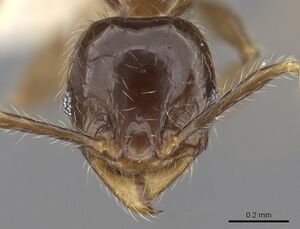   
| |
| Worker. Specimen code casent0281690. Photographer Estella Ortega, uploaded by California Academy of Sciences. | Owned by NHMUK, London, UK. |
   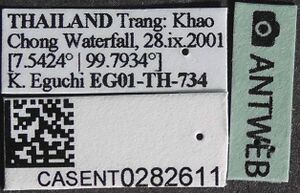
| |
| Not Provided. Worker. Specimen code casent0282611. Photographer Adam Lazarus, uploaded by California Academy of Sciences. | Owned by EPEC. |
 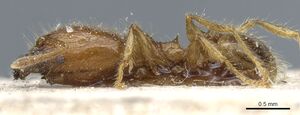  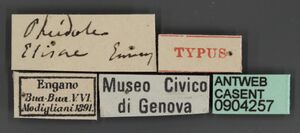
| |
| Syntype of Pheidole elisae. Worker (major/soldier). Specimen code casent0904257. Photographer Z. Lieberman, uploaded by California Academy of Sciences. | Owned by MSNG, Genoa, Italy. |
 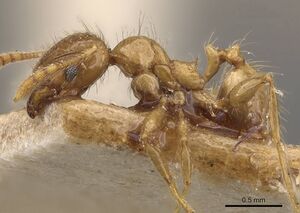  
| |
| Paralectotype of Pheidole elisae nenia. Worker. Specimen code casent0907974. Photographer Will Ericson, uploaded by California Academy of Sciences. | Owned by MHNG, Geneva, Switzerland. |
Major
Images from AntWeb
   
| |
| Lectotype of Pheidole elisae nenia. Worker (major/soldier). Specimen code casent0907973. Photographer Will Ericson, uploaded by California Academy of Sciences. | Owned by MHNG, Geneva, Switzerland. |
Nomenclature
The following information is derived from Barry Bolton's Online Catalogue of the Ants of the World.
- elisae. Pheidole elisae Emery, 1900d: 686 (s.) INDONESIA (Engano I.). Senior synonym of nenia: Eguchi, 2001b: 49.
- nenia. Pheidole elisae var. nenia Forel, 1913k: 30 (s.w.) INDONESIA (Sumatra). Junior synonym of elisae: Eguchi, 2001b: 49.
Unless otherwise noted the text for the remainder of this section is reported from the publication that includes the original description.
Description
Worker
Eguchi (2001a) - Major (n::5): TL 2.5-2.7 mm, HL 1.24-1.35 mm, HW 1.24-1.35 mm, SL 0.55-0.58 mm, FL 0.44-0.82 mm, CI 88-91, SI 48-50, FI 66-70. Head broadest at about 2/3 distance of head (as measured from the mid-point of a transverse line spanning the anteriormost and posteriormost projecting points, respectively) (Fig. 14A), in profile not impressed on vertex (Fig. 14B). Hypostoma bearing a pair of small median processes. Clypeus without a median longitudinal carina, with anterior margin distinctly emarginate medially. Eye situated at about 1/3 distance of head; distance between mandibular insertion and anterior margin of eye 1.5-1.7 times as long as maximal diameter of eye; eight ommatidia present on longest axis of eye. Frontal carina inconspicuous, extending backward to 3/5-2/3 distance of head. Antennal scrobe present only around antennal insertion. Antenna with 3-segmented club; antennal scape slightly extending beyond midlength of head; terminal segment 1.1-1.2 times as long as preceding two segments together. Masticatory margin of mandible with apical and pre apical teeth, without a conspicuous denticle in front of basal angle. Promesonotum forming a high dome, without a prominence on its posterior declivity (Fig. 14C); each dorsolateral portion of the dome not produced outward. Mesopleuron divided by a transverse impression into two parts, of which lower part is distinctly margined dorsally. Propodeal spine elongate-triangular or horn-like, 2-2.5 times as long as diameter of propodeal spiracle. Petiole 1.9-2.0 times as long as postpetiole (excluding helcium); petiolar node high (Fig. 14C), in posterior view not emarginate at apex. Postpetiole high, 1.5-1.6 times as broad as petiolar node.
Dorsum of head, excluding occipital lobe longitudinally rugose, with smooth and shining interspaces; occipital lobe smooth and shining over the surface (Fig. 14A); promesonotum smooth and shining, with several weak rugulae dorsally; upper part of mesopleuron and lateral side of propodeum weakly rugoso-reticulate; lower part of mesopleuron largely smooth and shining; lateral face of petiole very weakly punctured; dorsum of petiole, and postpetiole and gaster smooth and shining. Outer face of mandible sparsely covered with short appressed to decumbent hairs, which are 0.05-0.07 mm in length and almost as long as, or shorter than, distance between piligerous punctures. Body yellowish-brown or brown, with darker gaster (in majors collected in Merimbun and Belalong mandible, clypeus and dorsum of alitrunk and gaster are darker than the other part of body); flagella and legs sometimes a little lighter than alitrunk.
Minor (n=5): TL 1.7-1.9 mm, HL 0.53-0.62 mm, HW 0.50-0.58 mm, SL 0.49-0.54 mm, AL 0.72-0.83 mm, FL 0.58-0.66 mm, CI 91-96, SI 93-98, FI 112-115. Head in full-face view almost flat posteriorly (Fig. 14D); occipital carina almost absent dorsally on head. Clypeus frequently with a weak median longitudinal carina, with anterior margin in full-face view truncate medially. Eye situated just in front of midlength of head; distance between mandibular insertion and anterior margin of eye ca. 0.9 times as long as maximal diameter of eye (Fig. 14E); 6-7 ommatidia present on longest axis of eye. Frontal carina and antennal scrobe present only around antennal insertion. Antenna with 3-segmented club; in full-face view scape extending beyond posterior border of head by its 1/6 length; terminal segment 1.1-1.2 times as long as preceding two segments together. Promesonotal dome without any prominence on its posterior declivity (Fig. 14F). Mesopleuron divided by a transverse impression into two parts, of which lower part is distinctly margined dorsally. Propodeal spine triangular, 1.5-2 times as long as diameter of propodeal spiracle. Petiole 1.9-2.0 times as long as postpetiole (excluding helcium); petiolar node high (Fig. 14F), in posterior view not emarginate at apex. Postpetiole high, 1.3-1.5 times as broad as petiolar node.
Clypeus smooth and shining; remainder of head largely smooth and shining, but sometimes with several evanescent rugulae on its dorsum; promesonotum smooth and shining; mesopleuron and lateral face of propodeum slightly punctured at least partly; petiole and postpetiole largely smooth and shining; gaster smooth and shining. Body brown with lighter alitrunk (or lateral face of alitrunk); antennae and legs sometimes a little lighter than alitrunk.
Type Material
Eguchi (2001b) - major; Bua-Bua, Engano. One syntype (major, Museo Civico di Storia Naturale, Genoa) was examined.
References
- Eguchi, K. 2001a. A revision of the Bornean species of the ant genus Pheidole (Insecta: Hymenoptera: Formicidae: Myrmicinae). Tropics Monograph Series. 2:1-154. (page 49, Senior synonym of nenia)
- Eguchi, K. 2001b. A taxonomic study on Asian Pheidole (Hymenoptera, Formicidae): new synonymy, rank changes, lectotype designations and redescriptions. Insecta Koreana. 18:1-35.
- Emery, C. 1900d. Formiche raccolte da Elio Modigliani in Sumatra, Engano e Mentawei. [part]. Ann. Mus. Civ. Stor. Nat. 40[=(2(20): 661-688. (page 686, soldier described)
- Khachonpisitsak, S., Yamane, S., Sriwichai, P., Jaitrong, W. 2020. An updated checklist of the ants of Thailand (Hymenoptera, Formicidae). ZooKeys 998, 1–182 (doi:10.3897/zookeys.998.54902).
- Wang, W.Y., Soh, E.J.Y., Yong, G.W.J., Wong, M.K.L., Benoit Guénard, Economo, E.P., Yamane, S. 2022. Remarkable diversity in a little red dot: a comprehensive checklist of known ant species in Singapore (Hymenoptera: Formicidae) with notes on ecology and taxonomy. Asian Myrmecology 15: e015006 (doi:10.20362/am.015006).
References based on Global Ant Biodiversity Informatics
- Chapman, J. W., and Capco, S. R. 1951. Check list of the ants (Hymenoptera: Formicidae) of Asia. Monogr. Inst. Sci. Technol. Manila 1: 1-327
- Eguchi K. 2001. A revision of the Bornean species of the ant genus Pheidole (Insecta: Hymenoptera: Formicidae: Myrmicinae). Tropics Monograph Series 2: 1-154.
- Eguchi K. 2001. A taxonomic study on Asian Pheidole (Hymenoptera, Formicidae): new synonymy, rank changes, lectotype designations and redescriptions. Insecta Koreana 18: 1-35.
- Eguchi K., and S. Yamane. 2003. Species diversity of ants (Hymenoptera, Formicidae) in a lowland rainforest, northwestern Borneo. New Entomol. 52(1,2): 49-59.
- Emery C. Formiche raccolte da Elio Modigliani in Sumatra, Engano e Mentawei. Annali del Museo Civico di Storia Naturale 40: 661-722.
- Emery, C. "Formiche raccolte da Elio Modigliani in Sumatra, Engano e Mentawei." Annali del Museo Civico di Storia Naturale Giacomo Doria (Genova) (2) 20, no. 40 (1900): 661-722.
- Forel A. 1913k. Wissenschaftliche Ergebnisse einer Forschungsreise nach Ostindien ausgeführt im Auftrage der Kgl. Preuss. Akademie der Wissenschaften zu Berlin von H. v. Buttel-Reepen. II. Ameisen aus Sumatra, Java, Malacca und Ceylon. Gesammelt von Herrn Prof. Dr. v. Buttel-Reepen in den Jahren 1911-1912. Zoologische Jahrbücher. Abteilung für Systematik, Geographie und Biologie der Tiere 36:1-148.
- Hashimoto Y., Y. Morimoto, E. S. Widodo, and M. Mohamed. 2006. Vertical distribution pattern of ants in a Bornean tropical rainforest (Hymenoptera: Formicidae). Sociobiology 47(3): 697- 710.
- Ito, F.; Yamane, S.; Eguchi, K.; Noerdjito, W. A.; Kahono, S.; Tsuji, K.; Ohkawara, K.; Yamauchi, K.; Nishida, T.; Nakamura, K. 2001. Ant species diversity in the Bogor Botanic Garden, West Java, Indonesia, with descriptions of two new species of the genus Leptanilla (Hymenoptera, Formicidae). Tropics 10:379-404.
- Jaitrong W., and T. Ting-Nga. 2005. Ant fauna of Peninsular Botanical Garden (Khao Chong), Trang Province, Southern Thailand (Hymenoptera: Formicidae). The Thailand Natural History Museum Journal 1(2): 137-147.
- Pfeiffer M.; Mezger, D.; Hosoishi, S.; Bakhtiar, E. Y.; Kohout, R. J. 2011. The Formicidae of Borneo (Insecta: Hymenoptera): a preliminary species list. Asian Myrmecology 4:9-58


